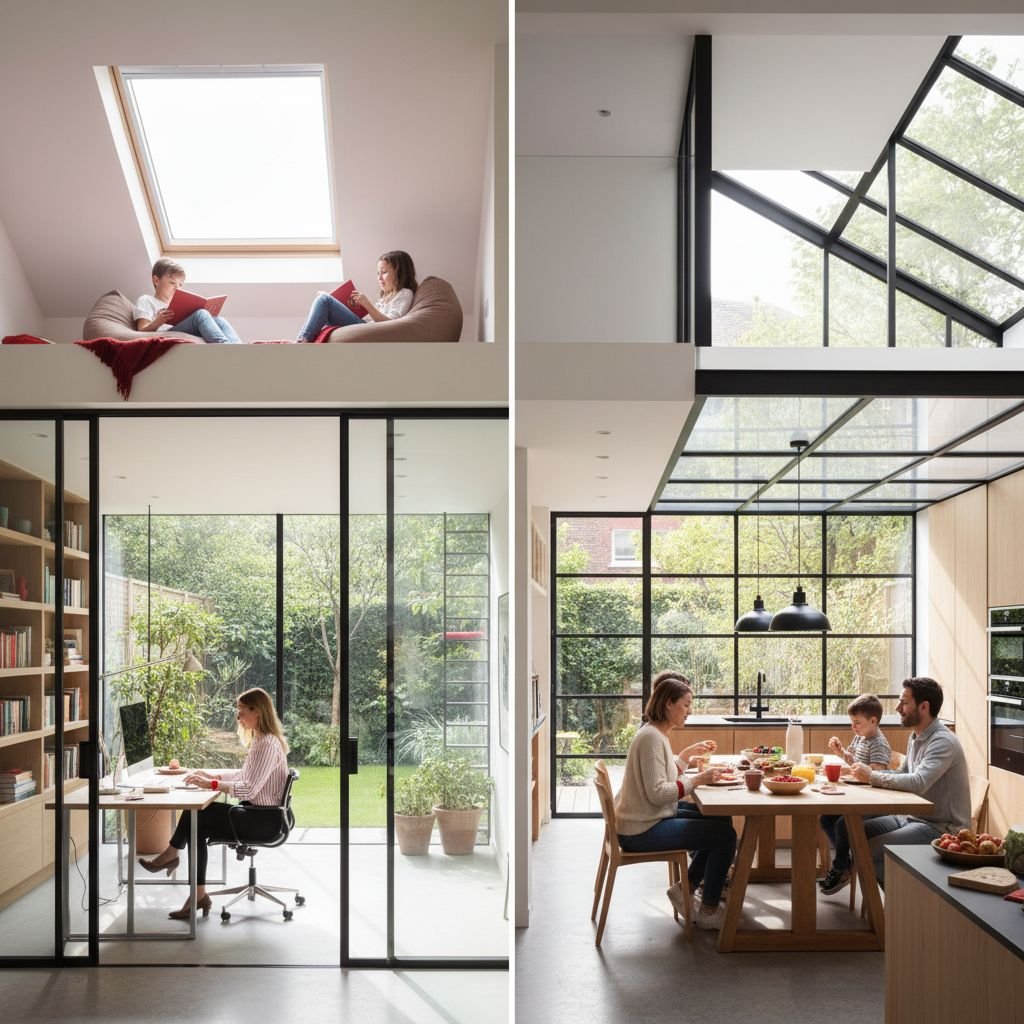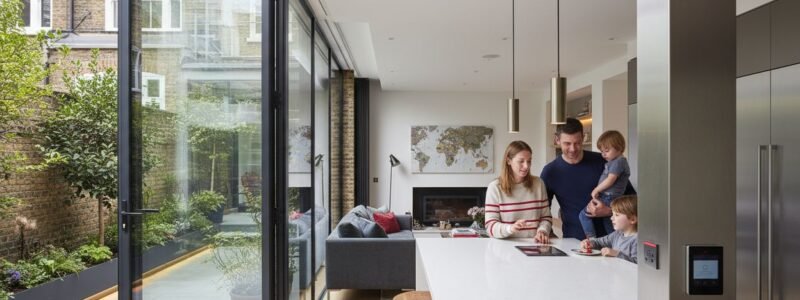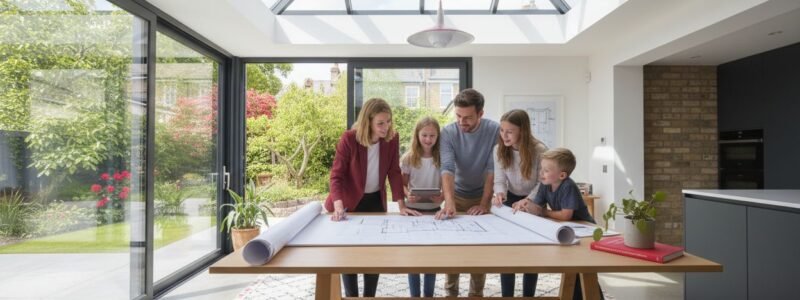Did you know that a well designed home extension can increase your property value by up to 25 percent? Many London homeowners are finding new ways to expand their living spaces without moving. From kitchen makeovers to light filled lofts and functional home offices, the right approach can transform how you live. Whether you want more room for family, work, or relaxation, making smart choices at every stage makes a lasting difference.
Quick Summary
| Takeaway | Explanation |
|---|---|
| 1. Define Your Extension Goals | Clearly outline your needs to inform design and budget decisions. |
| 2. Understand Planning Permissions | Familiarize yourself with permitted development rights to avoid complications. |
| 3. Maximize Natural Light | Utilize glass elements in extensions to enhance brightness and aesthetics. |
| 4. Design for Open-Plan Living | Create flexible spaces that foster interaction and connectivity in your home. |
| 5. Budget Wisely for Extensions | Plan financials carefully, accounting for various costs and potential overruns. |
Table of Contents
- Assessing Your Extension Needs And Goals
- Planning Permission Essentials In London
- Maximising Natural Light With Glass Extensions
- Kitchen Extensions For Open-Plan Living
- Creating Functional Home Office Spaces
- Utilising Loft And Attic Extensions
- Budgeting And Managing Your Extension Project
1. Assessing Your Extension Needs and Goals
Home extensions represent a powerful opportunity to transform your living space without the hassle of moving. Before diving into construction, understanding your specific needs and goals is crucial for a successful project.
Think of your extension as a strategic investment. Defining clear objectives helps you make informed decisions about design, budget, and functionality. Are you seeking extra living space, improving property value, or creating a more modern layout?
London homeowners often have unique challenges when considering home improvements. According to recent research, our guide on extension project management can help you navigate the complexities of home renovation.
Consider these key evaluation points:
- Space Requirements: Measure your current living areas and identify specific constraints or opportunities
- Lifestyle Needs: Determine how the extension will enhance your daily living experience
- Budget Constraints: Understand your financial limits and potential return on investment
- Property Potential: Assess how the extension might impact your home’s overall market value
For instance, a loft conversion can transform unused attic space into a functional room while potentially increasing property value by up to 20%. Alternatively, ground floor extensions offer more comprehensive layout flexibility, though they typically require more significant investment.
Your extension should not just add square metres but create meaningful living spaces that genuinely improve your home’s functionality and aesthetic appeal. Take time to visualise how each potential design might serve your family’s unique needs.
Remember: A well planned extension is more than a construction project. It is an opportunity to reimagine your living environment.
2. Planning Permission Essentials in London
Navigating planning permission can feel like solving a complex puzzle for London homeowners wanting to extend their properties. Understanding the legal landscape is crucial before starting any home improvement project.
Permitted development rights offer significant flexibility for homeowners. These special regulations allow many extensions without requiring full planning permission, provided specific criteria are met. Learn more about the detailed planning permission requirements to ensure a smooth extension process.
According to official planning guidelines, homeowners can typically undertake extensions with minimal bureaucratic intervention if they stay within certain limits. For instance, single storey rear extensions can often be constructed without comprehensive planning approval if they meet specific conditions:
- Extend no more than 3 to 4 metres for terraced and semi detached homes
- Maintain a maximum height of 4 metres
- Cover no more than 50% of the property’s original garden area
- Comply with specific design and material requirements
For larger projects exceeding these standard limits, prior approval becomes necessary. This process allows more substantial extensions with a streamlined approach. Detached homes can potentially extend up to 8 metres at the rear, while other property types might have a 6 metre limit. The prior approval process involves notifying neighbours and obtaining council assessment.
Key considerations before proceeding include:
- Checking your specific property’s permitted development rights
- Consulting local council guidelines
- Understanding potential restrictions in conservation areas
- Preparing detailed architectural plans
While permitted development rights offer significant flexibility, professional guidance can help you navigate potential complexities. Each London borough might have unique interpretations of planning regulations, so thorough research and potentially consulting a local planning expert is recommended.
Think of planning permission not as a barrier but as a protective framework ensuring high quality, considerate home improvements that respect both your property and neighbourhood.
3. Maximising Natural Light with Glass Extensions
Glass extensions represent a transformative approach to home design, turning previously dark and cramped spaces into luminous, breathable environments. By strategically incorporating glass elements, you can dramatically enhance your living space’s brightness and visual appeal.
Natural light is more than an aesthetic choice it is a fundamental element that impacts mood, productivity, and overall wellbeing. Discover how glazed extensions can revolutionise your home by creating seamless indoor outdoor connections.
Modern roof lanterns and glazing technologies have evolved significantly. Contemporary solutions like the Korniche system offer remarkable benefits:
- Ultra slim profile designs maximising glass surface area
- High thermal efficiency reducing energy costs
- Self cleaning glass technology minimising maintenance
- Simplified installation processes
In South London, innovative homeowners are already leveraging bespoke rooflights to transform kitchen extensions. These architectural interventions not only flood interiors with natural illumination but also create visual connections between indoor living spaces and exterior gardens.
When planning your glass extension, consider these strategic approaches:
- Orientation matters select south facing aspects for maximum sunlight
- Choose performance glazing with excellent insulation properties
- Integrate sliding or bifold glass doors to blur indoor outdoor boundaries
- Use reflective surfaces to amplify natural light distribution
The psychological and practical benefits of increased natural light cannot be overstated. Bright spaces feel larger, more inviting, and can significantly improve your daily living experience. A well designed glass extension is not just an architectural feature but a lifestyle enhancement.
Remember that glass extensions are an investment in your property’s value and your personal comfort. Thoughtful design can transform how you experience and interact with your living environment.
4. Kitchen Extensions for Open-Plan Living
Open-plan kitchen extensions have revolutionised modern home design, transforming traditional compartmentalised living spaces into dynamic, interactive environments. These extensions are about more than just additional square metres they represent a fundamental reimagining of how families live and interact.
Contemporary living demands flexible spaces that can seamlessly transition between cooking, dining, and socialising. Learn more about creating the perfect open-plan extension to understand how these designs can transform your home.
The magic of open-plan kitchen extensions lies in their ability to break down physical and psychological barriers. By removing walls, you create a sense of spaciousness that allows natural light to flow freely and encourages family connection. Imagine preparing meals while simultaneously watching children play or chatting with guests without feeling isolated in a traditional kitchen.
Key considerations for successful open-plan kitchen extensions include:
- Maintaining a cohesive design aesthetic
- Ensuring practical workflow in kitchen areas
- Creating distinct zones within the open space
- Incorporating sufficient storage solutions
- Balancing acoustic considerations
Design strategies can help define different functional areas without constructing physical barriers. Techniques like:
- Using different floor materials
- Implementing subtle level changes
- Positioning furniture strategically
- Employing varied lighting schemes
An open-plan kitchen extension is not just a home improvement project it is an investment in your lifestyle. These spaces support modern living by creating multipurpose areas that adapt to your changing needs throughout the day.
Careful planning transforms these extensions from mere architectural modifications into genuine lifestyle enhancements. Consider how your family lives, entertains, and interacts when designing your open-plan space to ensure it truly serves your unique requirements.
5. Creating Functional Home Office Spaces
The rise of remote working has transformed home offices from luxury spaces to essential living environments. A well designed home office extension can dramatically improve productivity, work life balance, and overall property value.
Dedicated workspace design is about more than just adding a room. Explore innovative extension design strategies to create a workspace that truly supports your professional needs.
Homeowners in London are increasingly recognising the value of purpose built home offices. According to recent research, adding a home office extension can potentially increase property value by up to 10%, while providing numerous lifestyle benefits such as reduced commute time and enhanced work flexibility.
Consider these key design elements for an effective home office extension:
- Natural light positioning
- Soundproofing capabilities
- Ergonomic layout considerations
- Integrated technology infrastructure
- Flexible furniture solutions
Loft conversions offer a particularly attractive option for creating dedicated workspaces. These extensions provide several advantages:
- Minimal disruption to existing living areas
- Faster implementation timelines
- Preservation of garden space
- Optimal use of previously unused attic areas
When planning your home office extension, think beyond immediate work requirements. Create a space that can adapt to changing professional needs, potentially serving as a multipurpose area that supports both work and personal projects.
The most successful home office extensions seamlessly integrate functionality with personal style. Consider your specific work patterns, technological requirements, and aesthetic preferences to design a space that genuinely enhances your professional productivity and personal comfort.
6. Utilising Loft and Attic Extensions
Loft extensions represent an ingenious solution for London homeowners seeking to maximise their existing property without compromising garden space. These transformative conversions turn neglected attic areas into valuable living spaces that can dramatically enhance both functionality and property value.
Space potential lies hidden above your ceiling. Explore our comprehensive extension inspiration guide to understand how attic spaces can be reimagined.
According to recent research, loft conversions are remarkably cost effective. Conversion costs range from approximately £19,000 for basic rooflight designs to £69,000 for more elaborate mansard configurations. More importantly, these extensions can potentially increase property value by up to 20 to 25 percent.
Key advantages of loft conversions include:
- Minimal disruption to existing living spaces
- Faster completion timelines (6 to 10 weeks)
- No reduction in garden or outdoor area
- Potential for significant property value increase
- Flexible usage options
When planning your loft extension, consider these critical design elements:
- Roof structure and headroom assessment
- Natural light integration
- Insulation and thermal efficiency
- Staircase placement and design
- Electrical and plumbing infrastructure
Loft spaces offer remarkable versatility. They can be transformed into bedrooms, home offices, studios, recreational areas, or even additional storage spaces. The key is thoughtful design that aligns with your specific lifestyle needs and property characteristics.
Budgeting wisely is crucial. Beyond the base conversion cost, factor in expenses for planning permissions, engineering assessments, and potential contingencies. A well executed loft extension is not just a room it is an investment in your property’s future potential.
7. Budgeting and Managing Your Extension Project
Home extensions represent a significant financial investment that requires meticulous planning and strategic management. Understanding the financial landscape is crucial for transforming your vision into a successful reality without unexpected financial strain.
Comprehensive project planning prevents costly mistakes. Explore our detailed project management guide to navigate your extension journey confidently.
In the London property market, extension costs can vary dramatically. Single storey extensions typically range from £50,000 to £100,000, while more complex wrap-around or double-storey projects might escalate to £120,000 to £200,000. These figures underscore the importance of thorough financial preparation.
Breakdown of typical extension budget allocation:
- Construction costs: 50 to 60 percent
- Interior finishes: 20 to 30 percent
- Professional fees: 10 to 15 percent
- Contingency reserve: 10 to 12.5 percent
Critical financial considerations include:
- Obtaining multiple contractor quotes
- Understanding all potential additional expenses
- Creating a comprehensive financial buffer
- Tracking expenses meticulously
- Planning for potential unexpected costs
Budget allocation requires strategic thinking. Calculate costs per square metre—typically between £1,800 and £3,500 depending on complexity—and factor in expenses beyond basic construction. Additional costs might include planning permissions, architectural drawings, party wall agreements, and VAT.
A successful extension project balances financial prudence with creative vision. By approaching your project with careful planning, transparent communication, and a realistic budget, you can transform your living space while maintaining financial stability.
Below is a comprehensive table summarizing the main strategies and considerations for home extensions discussed throughout the article.
| Topic | Description | Key Considerations |
|---|---|---|
| Assessing Needs | Evaluate the purpose of the extension, whether for extra space or property value. | Define clear objectives and evaluate space, budget, and property potential. |
| Planning Permission | Understand London’s legal requirements for home extensions. | Check permitted development rights, local guidelines, and conservation area restrictions. |
| Maximising Natural Light | Use glass extensions to enhance brightness and wellbeing. | Consider orientation, reflective surfaces, and performance glazing. |
| Open-Plan Living | Create a dynamic kitchen extension for flexible family interaction. | Ensure cohesive design, practical workflows, and clear zoning within spaces. |
| Home Office Spaces | Design a workspace that boosts productivity and property value. | Focus on natural light, soundproofing, ergonomics, and technology integration. |
| Loft and Attic Extensions | Transform attic spaces to increase functionality and property value. | Assess headroom, natural light, insulation, and usage flexibility. |
| Budgeting | Plan and manage finances effectively for a seamless extension project. | Obtain quotes, buffer finances, and allocate budget strategically across project elements. |
Transform Your Living Space with Expert Room Extension Solutions
Have you found yourself struggling with cramped rooms, a lack of natural light or the hassle of managing planning requirements for your London home extension? If the search for smart extension ideas has left you stressed about budget, compliance or creating the right flow, you are not alone. This article highlights key pain points like balancing functionality with style, staying within budget, and ensuring every new space, from kitchen diners to loft offices, truly enhances your day-to-day living. For even more ideas tailored to your lifestyle, explore our Extension Inspiration & Ideas for Your Home section, packed with practical tips and real-life success stories.
Why settle for generic plans when you can benefit from over 20 years of experience and complete peace of mind? At Reltic Extend, our team handles everything from design and transparent stage-by-stage pricing to planning permissions and project management. Ready to see the difference a bespoke extension can make? Discover all Types of Home Extensions & Ideas or take the first step by contacting our accredited specialists through our online form. Let us help you create a home that is spacious, functional and beautifully yours. Act now to secure a free initial consultation and start transforming your space with confidence.
Frequently Asked Questions
What are the key benefits of adding a room extension to my home?
Adding a room extension can significantly enhance your living space, improve functionality, and increase property value. Focus on defining your needs, such as creating a home office or expanding your kitchen, to ensure the extension meets your lifestyle requirements.
How can I determine the appropriate budget for my room extension project?
To establish a clear budget, assess the construction costs, interior finishes, and any professional fees you might incur. Start by gathering multiple contractor quotes and set aside a contingency reserve of approximately 10-12% of the total budget to cover unexpected expenses.
What planning permissions do I need to consider for a room extension?
Before starting a room extension, check if your project falls within permitted development rights. If it exceeds those limits, ensure you prepare detailed architectural plans and apply for any necessary planning permissions to avoid project delays.
How can I maximize natural light in my room extension?
Incorporate large windows or sliding doors and consider a glass roof to flood the space with natural light. Position your extension to face south if possible, as this orientation will capture sunlight effectively throughout the day.
What are the best room types for a home extension?
Popular options for home extensions include open-plan kitchens, home offices, and loft conversions. Determine which types serve your family’s specific needs most effectively, such as creating a functional workspace or expanding living areas for social interactions.
How long does a typical room extension project take?
Room extension projects generally take between 6 to 10 weeks, depending on the complexity and scope of the work. Plan ahead and organize your project management tasks early to keep everything on track within the timeline.
Recommended
- Lifestyle & Home Ideas for Modern Living | Reltic Extend
- 7 Innovative Living Room Extension Ideas for Your Home – Reltic Extend
- Extension Inspiration & Ideas for Your Home | Reltic Extend
- 7 Essential Home Extension Design Tips for Londoners – Reltic Extend
- Adaptive Toddler Beds: Space-Saving Solutions for Small Rooms | City Toddler Beds
- 7 Ways to Instantly Upgrade Your Living Space – STOMART.CO.UK





